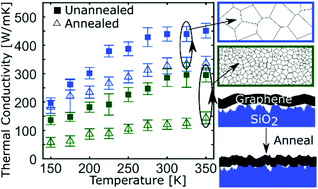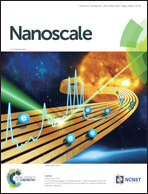Annealing and polycrystallinity effects on the thermal conductivity of supported CVD graphene monolayers†
Abstract
The thermal transport properties of graphene are strongly influenced by its contact environment and the strength of such interactions can be used to tailor these properties. Here we find that annealing suppresses the basal plane thermal conductivity (κ) of graphene supported on silicon dioxide, due to the increased conformity of graphene to the nanoscale asperities of the substrate after annealing. Intriguingly, increasing the polycrystallinity of graphene, grown by chemical vapor deposition on copper, increases the severity of this suppression after annealing, revealing the role of grain boundaries and associated defects in aiding phonon scattering by the substrate. In highly polycrystalline graphene, the value of κ after annealing is comparable to that after significant fluorination of an identical unannealed sample. Our experiments employ the suspended micro-bridge platform for basal plane thermal conductivity measurements. Using xenon difluoride gas for the final release also enables the investigation of thermal transport in graphene in contact with polymers. We find evidence for weaker phonon scattering in graphene, due to a 10 nm thick polymer layer on top compared to the pre-existing silicon dioxide substrate, which is a promising result for flexible electronics applications of graphene.



 Please wait while we load your content...
Please wait while we load your content...